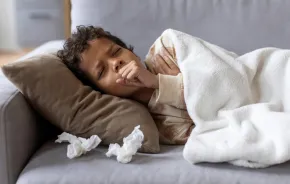
Editor's note: This article was sponsored by KidsQuest Children’s Museum.
Despite teachers’ heroic efforts during remote learning, there’s no doubt that the past year was far from ideal when it came to advancing our kids’ learning. But while parents are fretting over their kids’ laggard reading and math skills as they face a return to instruction this school year, one part of the school day often gets overlooked. When our kids missed out on recess last year, they lost out on a major learning opportunity. To get them back on developmental track, our kids need some serious play time.
The importance of hands-on play
“What’s so important with hands-on play is bodily kinesthetic movement. It allows for a lot of trial and error, experimentation, imagination and conversation that just naturally begin to happen as children are playing,” says Jamie Bonnett, director of education at KidsQuest Children’s Museum in Bellevue. Kids did not get these kinds of free-play interactions during breaks from screen time last year. Providing those opportunities now can do a lot more than help kids catch up with academics. Play is also a powerful tool for dealing with anxiety as we move into our new normal.
Play is important forever.
“Play is important forever,” says Putter Bert, president and CEO of KidsQuest. “We have to reteach adults how to play — or at least remind them of its importance.”
Now kids are having to relearn play as well. This past summer, KidsQuest offered in-person camps where the staff began to see — and repair — the learning gaps kids experienced during a year of social distancing.
“We’ve seen a greater impact with our 7- to 10-year-olds,” says Bonnett. Compared to preschoolers, students who participated in remote kindergarten and lower elementary grades got a lot more direct instruction, during which they were asked to sit at a computer and focus. That left a lot less time for play.
In a virtual classroom, kids don’t get the casual peer-to-peer interactions that are inevitable in a physical setting: sharing supplies or sitting themselves in a circle on the carpet for story time. They get a lot of practice using a mouse, but not much time with paper, pen and scissors.
KidsQuest offers solutions
“What we’re seeing are huge differences in kids’ fine motor skills. We’re having to back up and dig deeper into old skills,” says Bonnett. In the KidsQuest camps, 7- to 10-year-olds do an exercise in which they write instructions for making a sandwich. Students this year were able to articulate the steps. But they struggled to write the list on paper.
KidsQuest camps were designed to help kids regain and employ those fine motor skills by giving them opportunities to manipulate materials. Campers played games with chopsticks, sensory tubs and clay.
“We still let people touch stuff,” says Bert. And it was important that the museum didn’t feel too different when the building reopened.
“It was about opening back up and allowing the museum to do its job, which is to put children alongside each other with time and space to play,” says Bonnett. Those play interactions help kids practice listening, communicating, sharing and cooperating.
Safety first
While invaluable to development, such interactions can make parents nervous. The pandemic is not over, and, for now, kids younger than 12 remain unvaccinated. So, although KidsQuest is working to create the feeling of “the old normal,” it is still taking important precautions. Visitors to the museum are asked to wear masks, wash their hands, queue on the socially distanced dots and move through the museum along a one-way route during timed entry sessions with restricted capacity.
“We had to think about how many people an activity can safely accommodate,” says Bonnett. Some collaborative activities have been reconfigured, while in other areas the activities remain unchanged, but, ultimately, the number of participants is reduced.
Evidence indicates that the coronavirus does not spread on surfaces, but manipulated objects are rotated and cleaned on a vigorous schedule throughout the day. Protocols are constantly updated in consultation with local pediatricians and under the guidance of the American Pediatric Association.
“KidsQuest has been ranked as one of the cleanest museums in the country by a national study. It’s important that we had the parents’ trust,” says Bert. Since the building reopened in February with contact-tracing protocols, there has not been a single case of COVID-19 associated with the museum.
Play anxiety
After a year and a half of social distancing, having kids play in public spaces may seem like a daunting proposition to parents. Preparing kids — and ourselves — in advance can help everyone feel safe. Museum staff members are happy to discuss safety protocols in detail with concerned parents. For kids, resources such as the Low Sensory Storybook and videos about the museum on YouTube can help them understand what to expect and build excitement for what’s available inside the museum. Bonnett suggests driving by the museum before attending.
“Give your child time and grace if they’re anxious. Let them sit on the steps outside and watch others go in and out,” she advises.
Once you make it inside, Bert says, “We have an incredible staff, and they are all trained in how to play and how to help parents and kids cope with stress. Also, don’t feel like you have to ‘do the museum’ in one time slot. Take away the pressure to see everything in one visit. You can always come back again later.”
Play at home
For some families, later still seems better.
“It’s a choice to come to the museum,” says Bert. “There are all kinds of reasons a family won’t come to visit right now. But that doesn’t mean they can’t have a KidsQuest experience.”
Parents can purchase a KidsQuest play kit for use at home. Developed during the lockdown, these “playbooks” offer engaging learning play related to science, art, math, music and movement. Versions of the kits are available for different ages, both in English and Spanish.
For additional free activities, the KidsQuest YouTube and Instagram channels publish content for parents that provide instructions for making sensory bins, art projects and more. Additional at-home resources can be found on the museum’s website at Curiosity Corner.
“Play is so essential to becoming a successful adult. Play teaches us so much, no matter how old you are,” says Bert.
Bonnett adds that there is no wrong way to play. “Give your children an opportunity to be bored and play,” she says. If you give them enough time, they will come up with something on their own. It might not be what you intended, but that is also okay, she advises. “A lot of parents are worried about doing [play] wrong. Play is not perfect — it’s messy and loud and fun and unplanned.”
So, relax. Whether you visit the museum or stay at home, letting your kids play is just good parenting.
If you go ...Where: KidsQuest Children’s Museum, 1116 108th Ave. N.E., Bellevue When: Tuesday–Sunday, hours vary Tickets: $10 Parking: Free parking operates on a space-available basis. Detailed parking information is available on the KidsQuest website. |
|
Sponsored by: |

|











